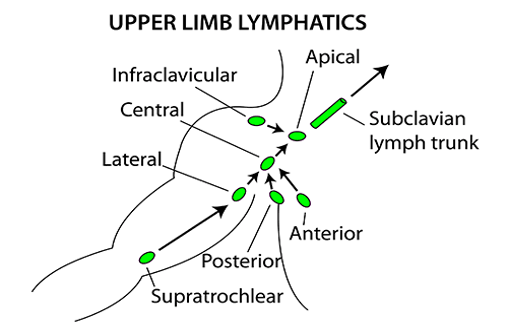Our body is made up of many wonderful and specialised components that carry out everyday tasks to support and sustain life.
Without our bones we would have no structure or substance to hold ourselves upright, think Harry Potter – when Lockhart tried to fix his broken arm and instead made the bone disappear! – his arm was made to look like a ragdoll, bendy and floppy!
Without circulation, nutrients could not gain access to all parts of our body and waste would not be removed.
Without tissues we would not have muscle, meaning we would not have any strength to do anything.
Without nerve endings to communicate all these processes, all of the above would stop.
Without an epidermis (skin) there is nothing to hold all the anatomy together.
The bones of each upper limb are formed by 30 separate bones and include the:
- Humerus
- Radius
- Ulna
- Carpals
- Metacarpals
- Phalanges
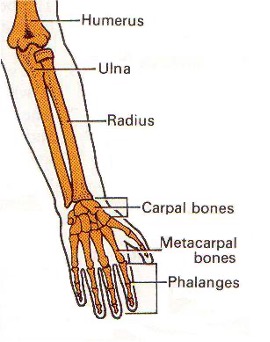
The humerus is a long bone that forms the upper arm between the shoulder and the elbow.
The rounded head at its proximal end fits into the shallow glenoid cavity of the scapula.
The distal end of the humerus has two surfaces that articulate with the radius and ulna to form the elbow joint.
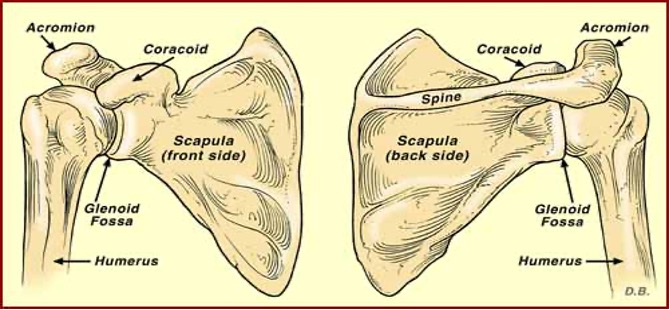
Together the radius and ulna make up the forearm and are located in between the humerus and the carpals. Anatomically the radius is the lateral bone of the forearm, on the thumb side and the ulna is the medial bone on the little finger side.
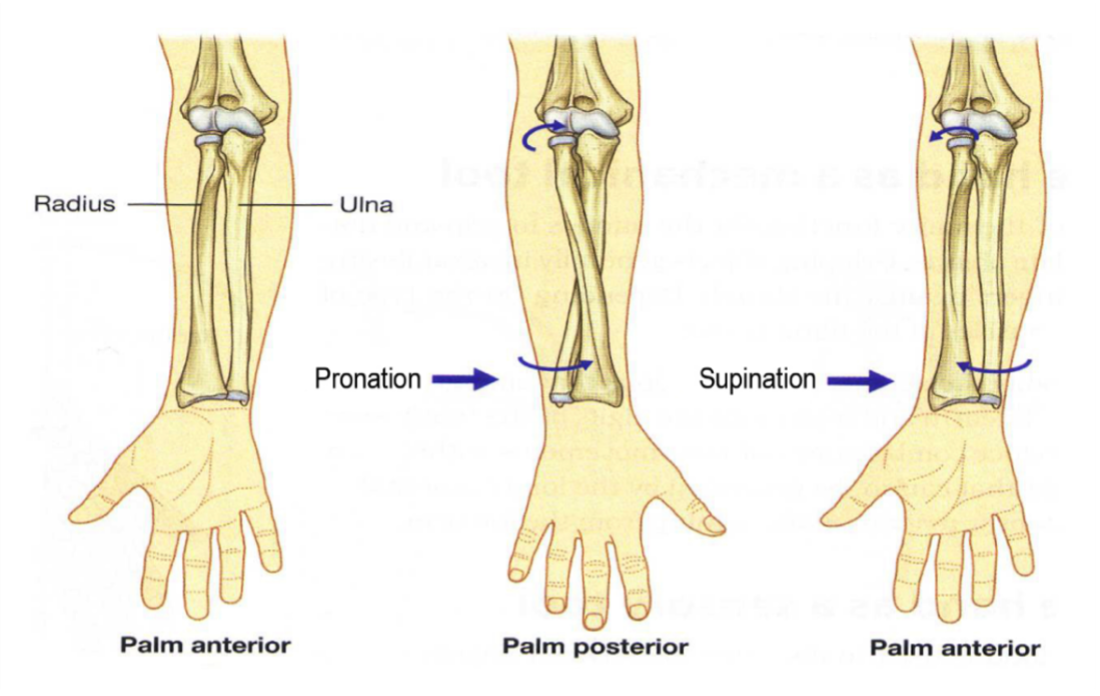
The hand is made up of 27 bones.
- 8 carpal bones, wrist
Irregular shaped bones arranged in two rows of four.
Bound together by ligaments that allow a gliding movement between them.
- 5 metacarpals, palm
Long bones with tiny muscles that allow the hand to close, open and fold.
- 14 phalanges, fingers
Each finger has three phalanges, and the thumb has two.
Long bones that have hinge joints between them allowing for closing or folding movements.
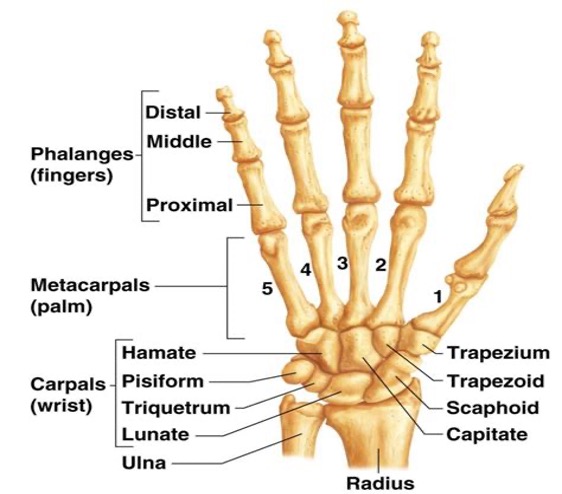
Muscles of the hand and arm
Our body contains over 600 muscles, ranging in size from extremely small to very large, depending on where they are situated and their action. These amazing tissues give us definition and strength and enable us to carry out everyday functions, from walking to picking something up with our fingertips. Some muscles are group together as they have similar actions or make up a larger muscle. The main muscles in the arms are;
A triangle shaped muscle that caps the top of the arm, from the clavicle over the humerus to the scapula, often called the shoulder muscle. Raises arms away from the body.
Sits at the front of the upper arm, which turns our hand to have the palm facing upwards and flexes the whole arm.
The muscle that sits opposite to the biceps, at the back of the upper arm, which extends the elbow joint.
There are number of these in our arms, both the upper and lower arm. Their function is to extend or lengthen a muscle. Extensor muscles are slightly weaker than flexors, which is why if you carry a heavy bag for a period of time, your arms ache, if you flex your muscles, i.e. hold the bag close to your chest (hug it), you are flexing your muscles and can carry in that position for a longer period of time.
As extensors we have a number of these through our arms. They flex or contact our muscle, e.g. make a fist, you are flexing your fingers.
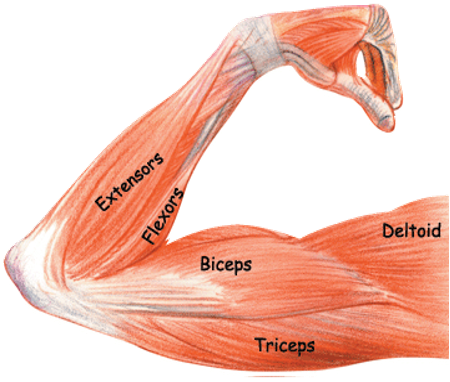
These are the thick muscles on either side of our palm. Thenar eminence (thumb muscle), controls our thumb movements, hypothenar eminence sits between our little finger and wrist, and controls the movement of the little finger.
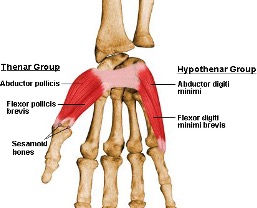
When we hear the word circulation we automatically think of our blood. Although this is correct, we need to remember our lymphatic circulation as well. The blood and lymphatic circulatory systems work very closely together and require a fine balance to help maintain internal homeostasis.
The arteries, capillaries and veins are tube like in construction. They transport blood to and from the heart and to various tissues of the body.
Arteries and veins are both deep and superficial, depending on their size and area they supply or drain, although most arteries are deep within our body, which is a form of protection. Arteries are much harder to stop bleeding than veins.
Arteries– are thick walled muscular and elastic tubes that carry pure blood away from the heart to the capillaries.
Capillaries– are minute, thin-walled blood vessels that connect the smaller arteries to the veins. Through their walls, the tissues receive nourishment and eliminate waste products.
Veins – are thin walled muscular and elastic tubes with valves that carry the blood from the capillaries back to the heart.
The skin and nails of the feet are nourished by a system of arteries, which bring blood to the tissue. When it is cold and when the circulation is poor, insufficient blood reaches the feet and toes. Severe circulation problems in the feet may lead to chilblains.
The arteries supply a constant source of nutrients and oxygen to all the tissues of the hand and arm.
Main arteries of the hand and arm
Brachial artery
- A division of the axillary artery and runs down the inner side of the upper arm, at the elbow it divides into the radial and ulnar arteries.
Radial artery
- Runs down the radial side of the forearm to the wrist, where it branches out to form a network of vessels called palmer arches, which supply the wrist, hand and fingers. When you take your pulse on the inside of the wrist, it is the radial artery you can feel.
Ulnar artery
- From the elbow to the wrist on the ulnar side of the forearm is the ulnar artery. At the wrist the ulnar artery, like the radial artery, branches to become palmer arches, supplying the wrist, hand and fingers.
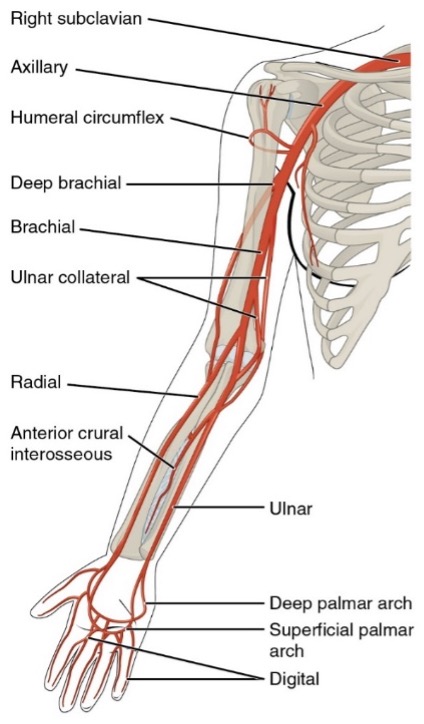
The veins work in conjunction with the lymphatic circulation to remove waste and CO2. Most of the deep veins sit close to the artery of the same name.
Main veins of the hand and arm
Cephalic vein (Superficial)
- This runs all the way from the hand to the shoulder, on the lateral side of the arm. It collects blood from the superficial veins in our hand. These are the ones you can see on your hand.
Basilic vein (Superficial)
- This vein is opposite the cephalic vein, it runs from the hand up to the underarm on the inner side or medial side of the arm. At the underarm area it merges with the brachial vein and becomes the axillary vein.
The basilic and cephalic veins have many smaller veins that link these two veins together

Radial vein (Deep)
- Sits on the radial side of the arm, after collecting blood from the hand it runs from the wrist to the elbow, where it merges with the ulnar vein to become the brachial vein.
Ulnar vein (Deep)
- After collecting blood from the hand, the ulnar vein runs from the ulnar side of the wrist to the elbow, where it merges with the radial vein, becoming the brachial vein.
Brachial vein (Deep)
- This vein flows from the inner elbow, curving around to the humerus up to the underarm where it merges to become the axillary vein.
We are lucky to have this system to keep our body in a healthy state. The lymphatic system has many functions, but predominantly it takes care of waste that cannot be removed by the venous circulation and aids our immune system. Excess fluid that is not reabsorbed by the veins, moves into lymph capillaries, where it is filtered as it is transported through the lymph circulation. Eventually it is emptied back into the blood stream. When our body is overloaded, either from excess fluid or fighting an infection, our lymphatic system can become overwhelmed, affecting the removal of fluid, this can lead to oedema (swelling). The swelling can be concentrated around the lymph nodes, e.g. when we get a throat infection, glands (nodes) swell in our throat area, and can be painful, as they try to fight the infection.
Although you do not need to learn all the nodes, having knowledge of the main ones, links to your practical, i.e. why we massage in an order or direction, why some points can feel tender (usually this is close to a node). The superficial lymphatic vessels are close to the superficial veins, and empty into the supratrochlear (inner elbow) and axillary nodes. Deep lymphatic vessels are close to deep veins and empty into the axillary nodes.
The main nodes in the arm
Axillary
- There is a group of nodes around the underarm arm area; central, anterior, posterior, lateral, apical. They drain and filter lymph from the breast, superficial chest, upper abdomen and the arm, before draining into the subclavian lymph trunk.
Supratrochlear
- Lymph from the lower arm and hand drains into the supratrochlear, after being filtered it moves up to the axillary nodes.
